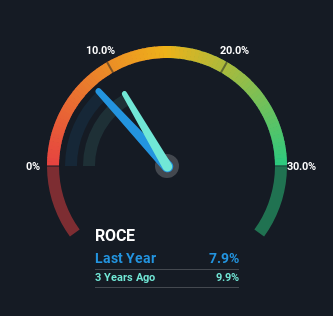Nath Bio-Genes (India) (NSE:NATHBIOGEN) Has More To Do To Multiply In Value Going Forward
Finding a business that has the potential to grow substantially is not easy, but it is possible if we look at a few key financial metrics. Firstly, we'll want to see a proven return on capital employed (ROCE) that is increasing, and secondly, an expanding base of capital employed. Basically this means that a company has profitable initiatives that it can continue to reinvest in, which is a trait of a compounding machine. Having said that, from a first glance at Nath Bio-Genes (India) (NSE:NATHBIOGEN) we aren't jumping out of our chairs at how returns are trending, but let's have a deeper look.
Understanding Return On Capital Employed (ROCE)
For those that aren't sure what ROCE is, it measures the amount of pre-tax profits a company can generate from the capital employed in its business. Analysts use this formula to calculate it for Nath Bio-Genes (India):
Return on Capital Employed = Earnings Before Interest and Tax (EBIT) ÷ (Total Assets - Current Liabilities)
0.079 = ₹481m ÷ (₹8.5b - ₹2.4b) (Based on the trailing twelve months to December 2023).
Thus, Nath Bio-Genes (India) has an ROCE of 7.9%. Ultimately, that's a low return and it under-performs the Food industry average of 15%.
Check out our latest analysis for Nath Bio-Genes (India)

While the past is not representative of the future, it can be helpful to know how a company has performed historically, which is why we have this chart above. If you'd like to look at how Nath Bio-Genes (India) has performed in the past in other metrics, you can view this free graph of Nath Bio-Genes (India)'s past earnings, revenue and cash flow.
What Does the ROCE Trend For Nath Bio-Genes (India) Tell Us?
In terms of Nath Bio-Genes (India)'s historical ROCE trend, it doesn't exactly demand attention. The company has consistently earned 7.9% for the last five years, and the capital employed within the business has risen 21% in that time. Given the company has increased the amount of capital employed, it appears the investments that have been made simply don't provide a high return on capital.
On another note, while the change in ROCE trend might not scream for attention, it's interesting that the current liabilities have actually gone up over the last five years. This is intriguing because if current liabilities hadn't increased to 28% of total assets, this reported ROCE would probably be less than7.9% because total capital employed would be higher.The 7.9% ROCE could be even lower if current liabilities weren't 28% of total assets, because the the formula would show a larger base of total capital employed. With that in mind, just be wary if this ratio increases in the future, because if it gets particularly high, this brings with it some new elements of risk.
The Bottom Line
In summary, Nath Bio-Genes (India) has simply been reinvesting capital and generating the same low rate of return as before. And in the last five years, the stock has given away 58% so the market doesn't look too hopeful on these trends strengthening any time soon. All in all, the inherent trends aren't typical of multi-baggers, so if that's what you're after, we think you might have more luck elsewhere.
On a final note, we found 3 warning signs for Nath Bio-Genes (India) (1 is significant) you should be aware of.
If you want to search for solid companies with great earnings, check out this free list of companies with good balance sheets and impressive returns on equity.
Valuation is complex, but we're here to simplify it.
Discover if Nath Bio-Genes (India) might be undervalued or overvalued with our detailed analysis, featuring fair value estimates, potential risks, dividends, insider trades, and its financial condition.
Access Free AnalysisHave feedback on this article? Concerned about the content? Get in touch with us directly. Alternatively, email editorial-team (at) simplywallst.com.
This article by Simply Wall St is general in nature. We provide commentary based on historical data and analyst forecasts only using an unbiased methodology and our articles are not intended to be financial advice. It does not constitute a recommendation to buy or sell any stock, and does not take account of your objectives, or your financial situation. We aim to bring you long-term focused analysis driven by fundamental data. Note that our analysis may not factor in the latest price-sensitive company announcements or qualitative material. Simply Wall St has no position in any stocks mentioned.
About NSEI:NATHBIOGEN
Nath Bio-Genes (India)
Engages in the production, processing, and marketing of hybrid and GM seeds in India and internationally.
Adequate balance sheet second-rate dividend payer.
Similar Companies
Market Insights
Community Narratives



